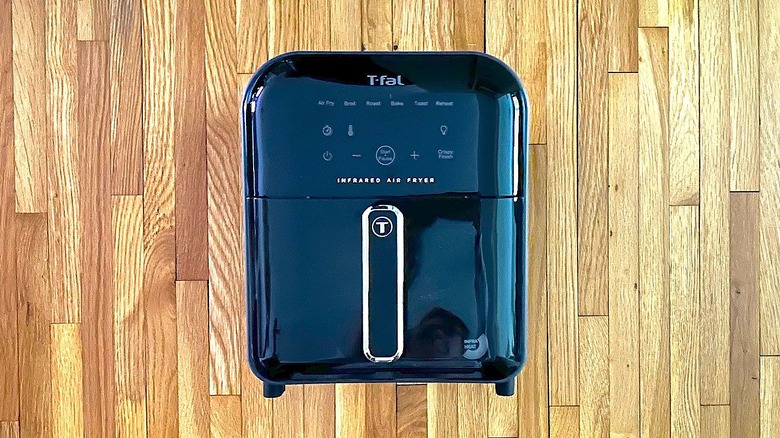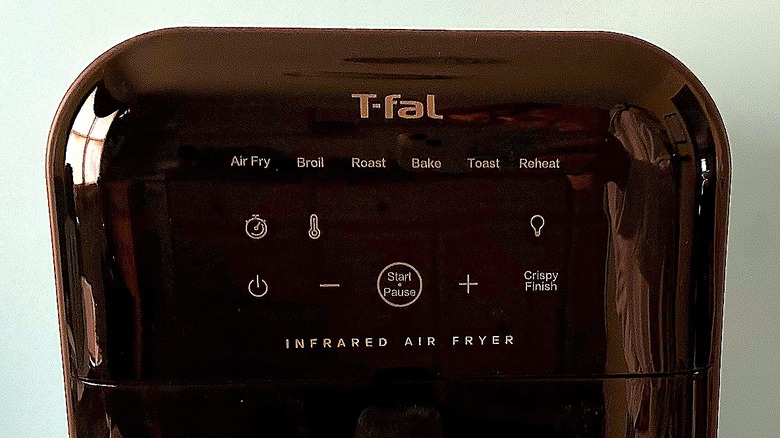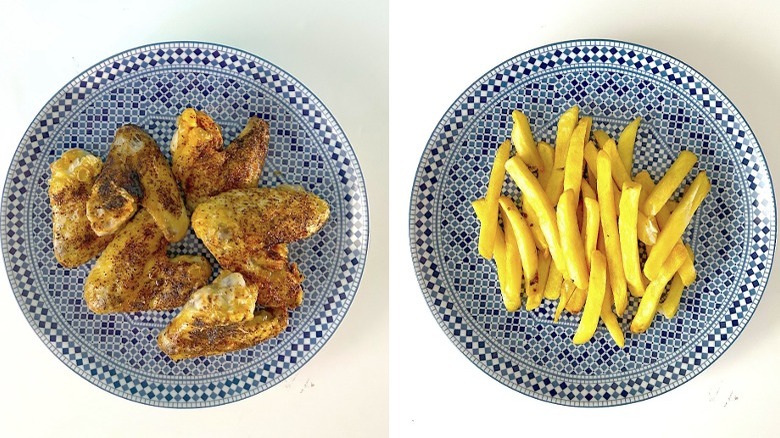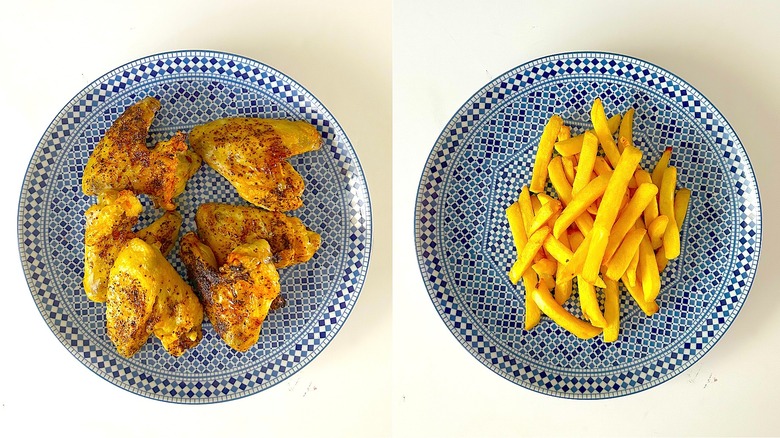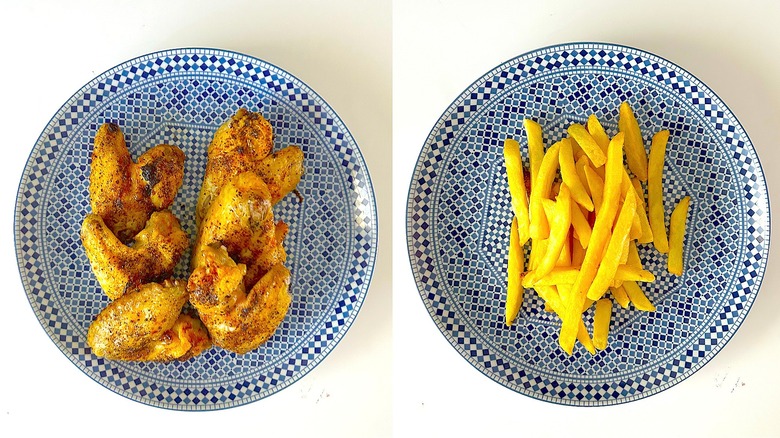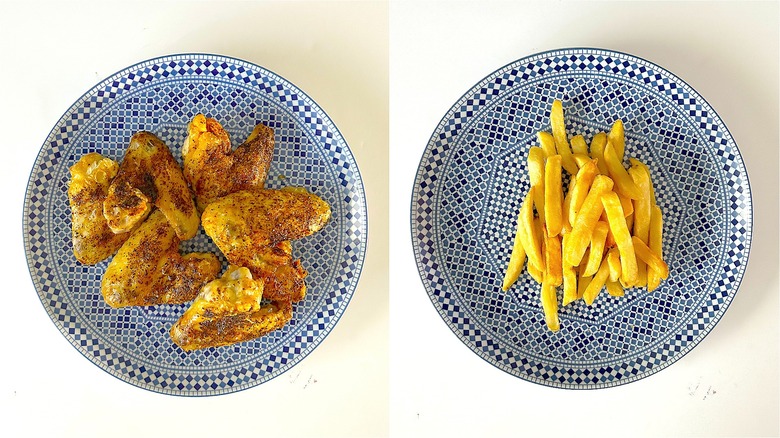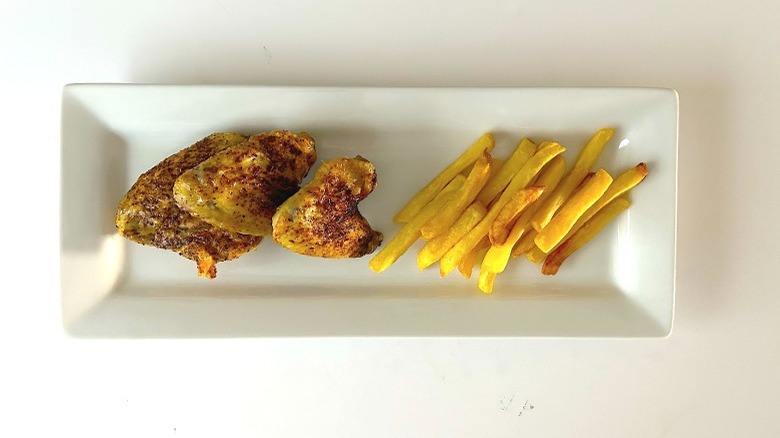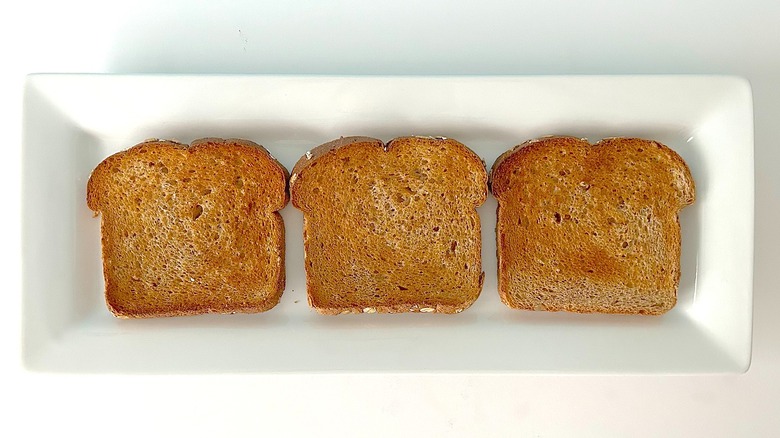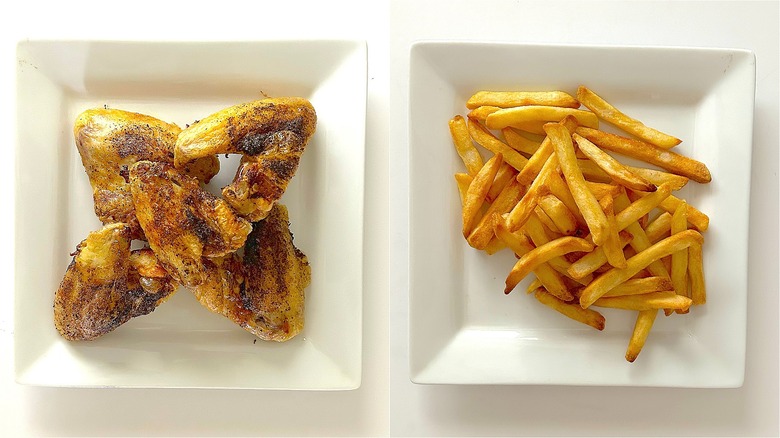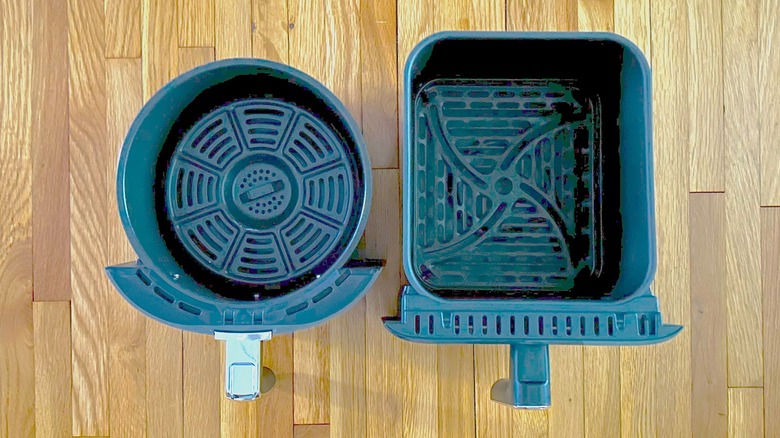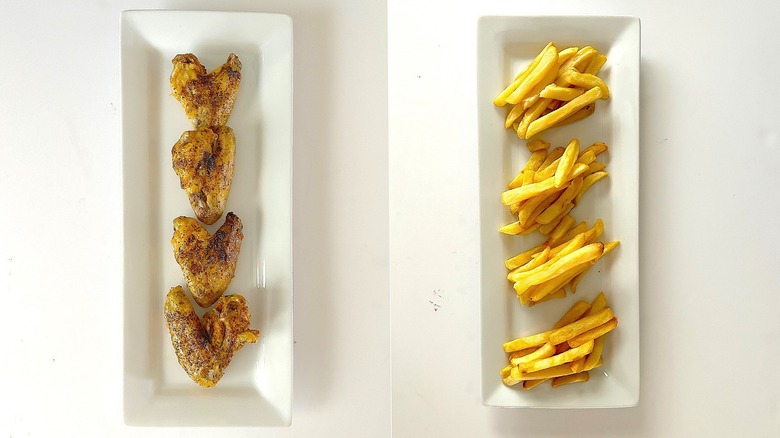Review: T-Fal's New Infrared Air Fryer Blew Us Away With Its Crisping Capabilities
We may receive a commission on purchases made from links.
Air fryers are popular because they can transform food rapidly by circulating heated air around it, thereby cooking and crisping it up. It often replaces deep frying as a culinary method, though the food made in one isn't technically fried, despite its moniker. There are many makes and models out there that do a great job, but some air fryers are inefficient, challenging to clean, and, the biggest downside can be their limited capacities. The innovators at T-Fal have come up with a solution to combat these common issues by introducing their new Infrared Air Fryer.
This air fryer not only uses infrared technology to speed up the cooking process, it has seven different cooking programs that are designed to replace virtually every other appliance in your kitchen, from the oven to the toaster. What's more, this unit comes with a unique Crisp Finish feature that adds a layer of crunch to any food.
While all this sounds fancy, I wanted to try this new air fryer out myself and compare it to my beloved Ninja Air Fryer. I tested every program on this fancy unit, including the Crisp Finish feature, by preparing chicken wings and french fries, two staples I make regularly using this appliance. Read on to discover if this air fryer from T-Fal lives up to the hype, and if you should make room for it on your kitchen countertop.
Some recommendations are based on first-hand impressions of promotional materials and products provided by the manufacturer/distributor/etc.
What is the cost and where can you purchase the T-Fal Infrared Air Fryer?
This new T-Fal Infrared Air Fryer is currently available via T-fal.com and Amazon at a cost of $129.99 plus tax. It has a 6.3-quart square basket, which is quite a bit larger than the 4-quart round one I'm accustomed to, making it roomier and more capable of feeding a larger family. It also has an easy-to-use digital touch screen featuring its various cooking programs, Crisp Finish feature, and adjustable time and temperature settings.
The carbon fiber surface eliminates the need for pre-heating the air fryer, while the infrared heat mimics that produced by open-fire cooking. Additional features include "No-Shake" technology, which means you don't have to stop the cooking process mid-way to toss your food to ensure even cooking, and a convenient lighted window through which you can monitor the progress of your meal. The seven cooking programs include: Air Fry, Broil, Roast, Bake, Reheat, Toast, and the Crisp Finish feature.
How well does the Air Fry cooking program work?
The Air Fry program is designed to cook food at a temperature of 375 degrees F for 10 minutes. The time can easily be adjusted as needed once the program is started. According to the Quick Start manual, this program is ideal for cooking salmon. I used it to test both a dry-rub chicken wing recipe and to reheat frozen french fries. Before seasoning or cooking the wings, I air-chilled them to dry out their skin. I also did not grease them or the pan, allowing for the fatty skin to do the work.
When making wings in my old air fryer, they took nearly 30 minutes to be cooked through at the same temperature. In this unit, they reached a safe minimum internal temperature of just above 165 degrees F within 20 minutes, though for the juiciest wings, you can (and should) cook them longer. These wings had a slightly crisp exterior, but weren't as crunchy as I generally prefer them. They were moist, but could have had more of a firm texture and savory flavor. That said, there was nothing wrong with them and they were quite tasty.
The frozen french fries were done in exactly 12 minutes. While they turned out fluffy and tender, their exterior was just barely crisp and not golden brown. I prefer my fries on the darker, crunchier side, so these weren't my favorite of the bunch I made.
How well does the Broil cooking program work?
The Broil program is pre-set to a temperature of 400 degrees F for 5 minutes. This program is the one recommended in the Quick Start manual for most applications, including chicken wings and frozen fries. It did, in fact, excel at both.
I prepared the chicken wings identically, air-chilling and seasoning them with a dry rub before setting them in the air fryer basket. The wings were ready in an astonishing 18 minutes. They smelled incredible, had a quite crisp crust, though were not as golden brown as I anticipated, and the internal texture was tender and juicy. I also felt they had a notably more meaty flavor, which may sound bizarre considering I used the same batch of chicken, but I felt the higher temperature encouraged more of the Maillard Reaction to act on the meat, amplifying its inherent umami-rich notes.
This setting was also the best option for the frozen french fries. To be fair, the instructions on the back of the package of fries recommends cooking them at 400 degrees for 10 minutes, with a stop five minutes in to shake the basket, which I did not do here as per the suggestion of the manufacturer. These fries were done in just under 10 minutes and had the perfect fluffy interior, crisp exterior, and a delightful golden brown hue.
How well does the Roast cooking program work?
The Roast program is designed to cook food at 350 degrees F for 20 minutes. It is considered the ideal setting to cook a whole chicken or cauliflower florets, according to the Quick Start guide. Because the temperature was lower than recommended for both chicken wings and frozen fries, I increased the time setting for both when cooking these.
Though they took a bit longer, 30 minutes versus 18, these chicken wings turned out wonderfully. They did have a terrific crunchy exterior and perfectly moist flesh that was comparable, if not just slightly less crisp, to those made using the Broil program. That said, if time is a factor, I'd still go with the Broil program to expedite the cooking process.
As far as frozen fries are concerned, I was somewhat less impressed with the results. Even at a longer cooking time of about 14 minutes, these fries lacked texture, having an almost starchy mouthfeel. They also felt rather lackluster in flavor, like stale fries. I suppose I could have left them in longer, but I am not sure that would have helped or dried them out even more. This was definitely my least favorite method for reheating frozen fries.
How well does the Bake cooking program work?
The Bake program is set at 325 degrees F and 15 minutes of cooking time. The manual suggests a couple of hacks depending on what you are baking. If you are using a recipe for a baked good from scratch or pre-made dough, it recommends reducing the temperature by 10 to 20 degrees. It also suggests using oven-safe dishes in the basket. Frozen or pre-made foods can also be heated using the Bake program, but the cooking time will likely be shorter than the manufacturer's instructions.
Though the Bake program isn't ideal for wings, it is possible to make them using this setting. They just take a very long time, roughly 35 minutes. The skin turns out the least crisp of the bunch, and the meat tends to dry out somewhat in the length of time it takes to cook the meat to a safe minimum internal temperature. That said, they were perfectly edible, just not great.
The fries experienced a similar fate using this program. By the time they were heated through, which took about 15 minutes, they were starting to get dry in the center, though they did not have the starchiness of the fries made using the Roast setting. These also had a crispier exterior, though not by much, making them a modicum better than the ones reheated using the Roast program. I look forward to testing this setting to actually bake brownies or a cake.
How well does the Reheat cooking program work?
After cooling and transferring the cooked chicken wings and fries to an airtight container, I refrigerated them overnight before testing the Reheat program. The pre-set temperature and time of this program is 300 degrees and five minutes. It promises to reheat food while retaining moisture, something that is typically problematic with a microwave oven, especially with chicken.
The Quick Start manual suggests you can warm both the chicken and fries simultaneously, so I placed them both in the basket before turning the Reheat program on. When the program was done, the food was hot, but not as hot as I would prefer. I would likely set the program a couple of minutes longer to have the food at the temperature I would like it to be. That said, both the wings and fries were thoroughly warm from the inside out.
The fries did not crisp up as much as I would have enjoyed, but they were fine. The wings were as moist and flavorful as they were when I first cooked them, something I can never say when microwaving chicken wings. Overall, I'd say the reheat function is a great way of preserving the quality of a meal when using up leftovers, you may just need to play around with the timing somewhat to ensure the food is heated to your desire.
How well does the Toast cooking program work?
The Toast program is presumably designed to eliminate the need for a toaster, which I appreciate. This setting is programmed to 400 degrees F and lasts just 2 minutes. The Quick Start manual suggests you can toast a bagel in this amount of time, which, based on my experience, seems impossible.
I attempted to toast very thinly-sliced whole wheat bread using this program. The bread barely began to get crisp using the pre-set 2 minute program. I didn't achieve what I consider to be an adequate toast, which, in my opinion, should be a medium-brown hue and have a nice crunch to it, until I ran the program twice, for a total of 4 minutes.
While this is not a deal breaker, it is something to be aware of. That said, I also know that the definition of the perfect toast varies from person to person, and factors like the type of bread can impact how quickly it dries out and begins to brown, so take this observation with a grain of salt.
How well does the Crisp Finish function work?
The Crisp Finish function can be applied after using any of the previous programs. It raises the temperature of the air fryer to 450 degrees F for 2 minutes, though it can be used for any length of time you would like to attain the texture you desire. If there was one feature of this air fryer I can say unequivocally I like the best, besides the convenient window, it is this one.
To test this function, I removed half the wings or fries I cooked using each pre-set program and left the other half in the air fryer. I continued cooking those using the Crisp Finish feature. In each case, I found the wings or fries that were allowed to cook using this feature to be a more satiating texture and to have a more robust flavor.
This is particularly true for the wings. The wings develop a crunch that you might only attain by deep frying them, without the dark color or extra fat, which is awesome. The only hitch in the giddy up with this feature is that it does such a great job crisping up the chicken skin, which I usually do not eat, I was tempted to eat all of the skin. Seriously, these wings were habit forming. And, while my cardiologist might not approve of eating all that skin, as a professional chef, I can safely say, these wings are "chef-approved."
How easy is it to clean the T-Fal Infrared Air Fryer?
One thing that often gets overlooked when it comes to choosing an air fryer is how easy it is to clean. Cleaning an air fryer between uses is more important than you might think. Not only can the residual grease and drippings cause it to work less efficiently by clogging up the unit and inhibiting air flow, it can prevent it from heating up quickly. Additionally, this caked on food can attract pests and might transfer pathogens, neither of which is particularly appetizing.
The exterior of this air fryer can easily be wiped down using a soft cloth and anti-bacterial cleaning product. The basket itself is not dishwasher safe, though the removable tray is. That said, it is quite simple to clean. I soaked the entire basket, along with the tray, in hot, soapy water for about 10 minutes. After that, the basket and tray came clean rather quickly. I allowed these to air dry before putting them back into the air fryer. If you are concerned about bacterial residue, any remaining pathogens will likely be killed by the high heat of the interior of the air fryer.
Lastly, be cautious of using an abrasive scrubber, like steel wool, to clean the basket and tray of this air fryer. Doing so can scratch them, damaging the coating and compromising it. It is best to let dish soap with a degreaser and time do the work for you.
Final thoughts
Because this air fryer is a bit pricier, I want to provide pros and cons before giving my final verdict. Pros include the efficiency, versatility, and capacity of this unit. I love the Crisp Finish feature and the fact that you do not need to shake food in the middle of cooking. I am also extremely fond of the lighted window, which makes it easy to monitor the progress of food as it cooks.
In terms of cons, there are only two. First, I was not anticipating the touchscreen of the control panel to be so sensitive. When I first plugged the unit in and tried to turn it on, I was pressing the power button too hard so it wouldn't turn on. It wasn't until I realized all I needed to do to activate it was to tap it that it finally turned on. For a few minutes, I was convinced the display panel was broken, which may be helpful for new owners who encounter the same issue. The second potential issue is that the tray in the basket has holes in it that are large enough for smaller pieces of food to fall through. I found this especially relevant with the French fries, as the smaller pieces fell through, making it impossible to retrieve them until I disassembled the unit to clean it.
So, would I buy this air fryer? Absolutely. I think it revolutionizes air frying and may eliminate the need for other appliances.
